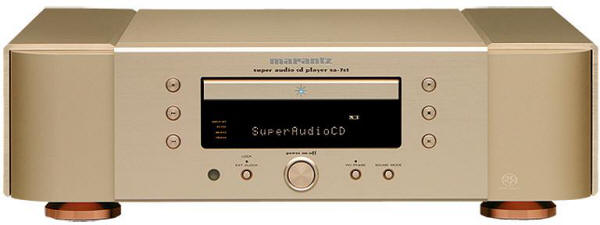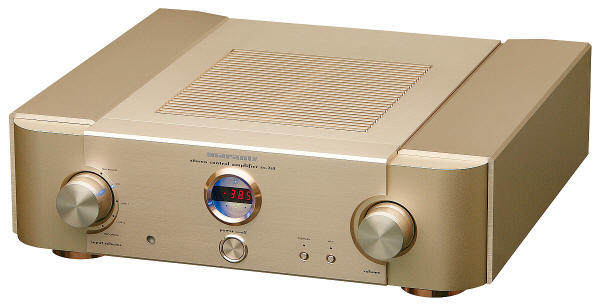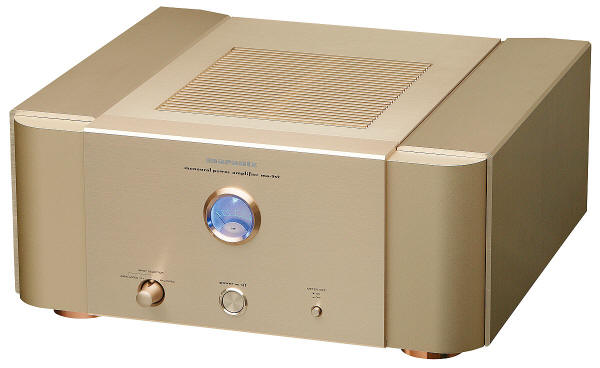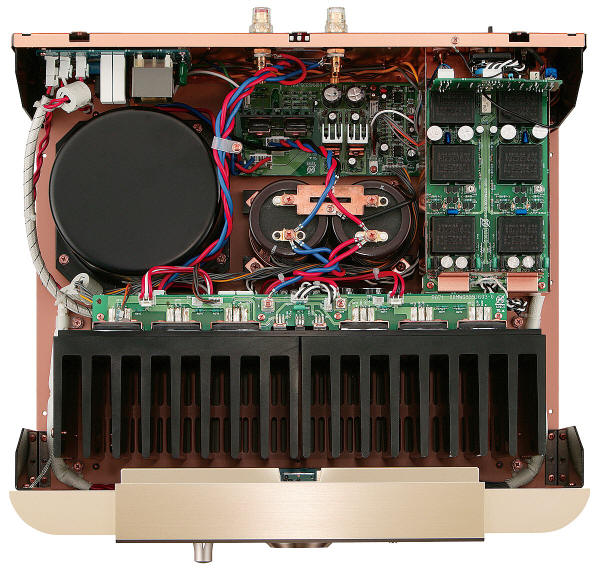You are reading the older HTML site
Positive Feedback ISSUE
july/august 2008

The Synergy of Similarity - A Case for Compatibility
The Marantz Reference System (SA-7S1 SACD player [previously reviewed}, SC-7S2 Control Amplifier, MA-9S2 Monaural Power Amplifiers)
The History of the Audio World - Part Two
Marantz. In this day of flash in the pan, "now you see 'em, now you don't" esoteric audio equipment designers and manufacturers, Marantz remains, having celebrated their 50th anniversary in 2003.
As with many of the nascent audio companies of the time, the exogenesis of Marantz was one person's (Saul Marantz's) frustration with the quality of equipment available at the time (as the LP was emerging as the primary driver in the evolution of fine audio). Saul designed his first piece, a pre-amplifier (the Audio Consolette) to address the myriad of recording equalization curves in use at the time. There was sufficient interest in this "home-grown" product to make a few units for friends, et al, but by the end of the first year he had orders for over 400 units.
Marantz, as a company, came into being in 1953 and the Audio Consolette (now morphed into the original mono Model 1 preamplifier) was its first product. The feature rich and great sounding Model 1 was a revelation. A mono power amplifier (the Model 2) followed in 1956. In 1957 arguably the most famous of all the Marantz designs hit the streets, the Model 7c stereo preamp (over a hundred thousand pieces were sold). Throughout the sixties, innovations continued to appear, including the legendary Model 9 amplifier and a tube FM tuner.
In 1964 Saul sold Marantz to Superscope, Inc. He stayed on for a few years and then left the company completely. By 1975 Superscope had assumed a controlling interest in Standard Radio Corporation which became Marantz Japan. In 1980 the Marantz operation was sold to Royal Phillips Electronics.
Under Phillips, Marantz entered the digital transition early on with the CD-63 player coming out in 1982. Marantz did its first DSD machine (The SA-1) in 1999. Marantz transitioned out of Phillips and is now contained within D & H Holdings, established in 2002 to integrate Marantz and Denon under a single umbrella.
Today, mass market products dominate the Marantz line, but (I suppose) much as a car company will use the innovations arising from short production run, specialty performance models (such as the original BMW "M" cars) and from racing, the Reference line is the current Marantz expression of their best engineering.
The line itself is substantial, providing a "stepped" series of choices from two integrated amplifiers, separate control amplifier and stereo amplifier, to the flagship monoblocks (and not forgetting the two SA players, and even a turntable).
Introduction
Regular readers know of my ongoing love affair with the Marantz SA-7S, SACD player. In this delicate dance we serious audiophiles do among: performance, price, reliability, voicing, visual aesthetics and the like, I think I finally found my girl (after a considerable amount of dating, and even some extended affairs). And yes, I continue to look at the field (I may be old, but I am not dead). But, I think this particular part of my audio team is a long-term keeper. I simply have not heard anything south of $10k that begins to compete with it, and for sheer musicality, I have not heard anything I prefer.
I know I promised to do a comparison with the new little sister SA-11S2, but I have not been able to pry one from Kevin Zarrow's hands. Apparently, Marantz is still selling them as fast as they can be made.

Frankly, before the SA-7S1 it had been a long time since I had given Marantz much thought. I assumed they had made the transition to mass-market audio and HT, and that was that. But I was so impressed with the SA-7S1 when it came in for review; I became curious about the whole Reference line. Of course, I had read some snippets of things about their "reference" level equipment, but again, I hadn't paid much attention. We audiophiles do this. We assume we already know, and so we write things off without ever checking our assumptions. Dumb.
When I took a background look at the line, I was struck by both the similarity in visual appeal, which is not surprising, and the many parallels of design (insofar as I am able to understand the technical aspects). It occurred to me that maybe the things I liked about the SA player might also characterize the amplification. I know, I am just quick that way.
So, after some delays, three big boxes arrived from Marantz. My impressions, as they were unboxed and the equipment placed, were very much the same as with the SA-player …even the outside dimensions were close, making for a very nice visual effect. The three pieces are substantial but not overly so, pretty without being prissy, a bit feature-rich for the hair-shirted I suspect, but appreciated on my end (now if I could just get tone-controls). I smiled to see meters on the faces of the amps even though they are a bit diminutive for these old eyes.
Fully balanced, one can elect (by switch) either balanced or single-ended operation from source to amplification, but unfortunately, you can't mix outputs from the pre (such as to drive subs, while using the balanced output to drive the power amplifiers), and you only get a single balanced input into the control amplifier.
I elected to run in single-ended mode, rather than lose the bass reinforcement. But this idea of being able to simply switch back and forth between single-ended and balanced operation is hugely convenient. This way, the listener is not "dictated" to, and there is no need for adaptors and all the potentially problematic issues with cabling (using interconnects designed for balanced operation in single-ended application is potentially a problem).

The SC-7S2 Control Amplifier even comes with a built-in phono stage, but it is intended for MM carts, so I could not use it.
Short course on the functionality; while a teeny bit idiosyncratic (multiple switchable inputs on the amplifier, which are also switchable from single-ended to balanced, etc.), everything has that consistent silky operational feel and richness usually reserved for more expensive gear.
Along with giving Marantz engineers and designers their propers, I still think part of this is the economy of scale which allows a company this size to enjoy cost of manufacturing advantages smaller competitors lack. The Marantz reference gear is not inexpensive by any measure, but I suspect similar quality products from a smaller manufacturer would cost considerably more and would offer significantly fewer amenities.

Theory of Operation
Let's us not kid ourselves, or rather, let me not kid you. There is extensive technical information available for these pieces for those of you so inclined and savvy enough to at least believe you understand them, but I am pretty much done with any pretense that I would be doing anything other than simply quoting the manufacturer in commenting on such; so moving along…
My real curiosity arises out of this on-going discussion about Marantz's ubiquitous use of HDAM's in both the players and the amplification pieces.
I have seen both assertions …the HDAM's are the work of the devil and must be expunged by the first modifier you can trust your equipment to, and the contrary assertion that they are responsible for a lot of what I (and apparently a lot of other people) like about the sound of the SA-7S1 (and presumably the 11.2) player.
The only reasonable hypothesis testing (at least until and if Jennifer Whitewolf-Crock starts modding her SA-7) I have at my disposal is to see if the amplification "sounds" like the player does. If it does, then I will probably conclude the HDAM's are a good thing, 'cause I really like the player in its stock form.
So Doc, How does it sound?
I think that audiophiles are often best served by simpler choices.
For example, I have long championed the use of high-quality integrateds. There are many excellent pieces out there in pretty much any price range and topology one might desire; BAT, WAVAC, LSA, my little Ming Da EL-34 AB, etc. I truly believe that a high percentage of audio enthusiasts could and would find happiness therein, and instead of fussing about yet another component and more wire and such, they could focus on other things (and be better able to afford them).
I feel the same way about "house sound." If you are buying from a competent and reliable designer/manufacturer, chances are there will be at least a thread of a common voicing through their products (after all designers tend to have enduring views of the world and what they are doing), and perhaps even more importantly, you shouldn't have to wonder how one piece will work with another within the same line.
So, putting my time and effort where my mouth is, it seemed only reasonable to give the Marantz Reference line a shot, in the continuing context of my appreciation for their SACD player.
Qualitative and Preferential Distinctions
In the context of my long-term reference BAT gear, the cumulative presentation of the Marantz Reference system could not be more different, while still being qualitatively quite similar. This apparent paradox delights me.
We humans are so accustomed to being hierarchical and narcissistic that we barely know when it is happening. In this pointless battle to determine what is best we lose the richness of the rest of that sentence, which is, "according to whom or what?" Is there a defensible hierarchy of quality here to be discerned, and who determines where things fall within it?
Now, please don't misunderstand …I am not going down this inexplicable PC rabbit hole I observe in my younger colleagues and friends, who are so conditioned to enhance esteem and value differences, that everything becomes qualitatively equal, just taste or interest differentiated. I don't buy that "blanding" of art at all. I cringe when I hear Joni Mitchell has likened herself to Beethoven. I love Joni's music; I truly do, but please! To even hint there is some qualitative parity is hubris …or the result of reduced arterial blood flow to the brain.
However, when qualitative aspects are reasonably comparable, it comes down to taste, personal preferences and individual choice. Hell, even when there is a significant supposed qualitative difference, ultimately personal taste and preference does and probably should out. After all, it's your money and your system.
Just because it is better, doesn't mean you will prefer it. That being said, while it may well be that you prefer "A Case of You," to the "Ode to Joy" …just because you like it better, doesn't mean that it is better. I watched Cheech and Chong's Next Movie (which I have, of course, seen before) last night and laughed my ass off. I would never assert this is a good movie, but that in no way diminished by enjoyment of it. Also, earlier this week I watched the critically acclaimed Silk, and was clinically dead during at least three parts of this virtual still-life of a movie. It may be better, but I would rather be tied up and forced to watch golf on TV, than ever see it again.
Translating Preferences into Principles
I have lost count of the number of times I have exchanged listening experiences with other audiophiles, who will invariably tell me about the shortcoming of my system, and then I go listen to theirs and generate a list of my own …or more commonly, just keep my mouth shut, because after all, if you can't say something nice...
My longest term and most frequent (and virtually the only positive) experiences of this phenomenon are with David Robinson. He is one of my most dear and enduring friends, and we agree on many, many things about audio; most, in fact. Because we live reasonably close, we have been able to visit each other's listening rooms through countless iterations. However, ultimately we seem to prefer a somewhat different overall presentation. I won't characterize what I think the differences are, because they are the differences I hear, and I am sure David experiences them at least somewhat differently (but he is too polite to say). And, besides, it hardly matters.
But here is the real issue …David and I are both, arguably, quite sophisticated consumers; not just of audio, but of most things musical, including both of us having being musicians most of our life. We are certainly comparably interested, and both very open to new experiences and learning as we go. And yet, we follow different paths to some extent.
The Doctor's Quandary
In most of my life, I have a wide range of tastes, from women to cars. I am equally appreciative of fine farm cooking, as something fussy in a tiny big-city bistro. I love rock, Celtic music, jazz, classical and pop music equally, without ever asserting (or thinking) they are qualitatively equivalent to each other.
And within all this range, I have preferences. I actually used to try to develop rationales for my preferences …to justify, or at least explain them to others. Now I just say,
"If you come near me with a beet in any form, the meal is officially over," or, "I don't care what anyone says, baroque music generally bores me to absolute tears," or "Yes, I do think that much opera consists of fat people screaming at each other."
And more joyously, when reprimanded for these positions I just smile relax in the peaceful realization the other person is unaccountably wrong, and they just don't realize this. One cannot cure the ignorance of the world (did I mention that humans are by nature, narcissistic?).
But seriously, this "one path" thing in audio is a bore. It doesn't work for religion or anything else, why in the world would it work for audio?
Now, after that little trip through the woods sans breadcrumbs, back to my original point ...the Marantz and BAT reference gear could hardly be more different in design, construction and presentation. I assert they are qualitatively comparable. I also say they do not sound at all alike.
Aye, but there's the rub; if both sound differently, and there has to be a "right" …how do we determine which one is truly correct? Which of the two systems most faithfully reproduces the sound of unamplified acoustic instruments in a given recording space? Sorry, I stared at that last sentence for some time, and I know it is sarcastic, but …sue me.

MA-9S2 Reference Monaural Power Amplifier
Whatever the "reference" the fact remains, it can't be that both are faithful reproductions if they sound differently (which they do), because that would sort of negate the whole issue of an absolute reference (whatever it might be). The specifications are not helpful, because we are comparing somewhat unlike things (my BAT system uses tubes in both the phono and preamplifier stages).
My dilemma is compounded by the fact I have recordings at my disposal I have either made, or participated in the making of …so I was there …what better absolute reference than that?
Madness ensues.
The Path of the Vinegar Taster
In my own demented little Taoist way, I will contend the Marantz and BAT reference systems are comparable in quality and most importantly, provide potential owners with clearly drawn preferential choices. I cannot imagine these two systems not polarizing most listeners, especially when we toss in the tube issue.
Well, that is …except for people like me. I like 'em both, and after hearing the Marantz gear on the CMS stands (preview published August, 2008), neither system gives up anything fundamental to the other: resolution, musicality, dynamics, build quality, functionality …the entire panoply of elements is comparable, while being very different.
Wheeeeee, what a predicament!
The Marantz "sound"
Is there a "house" Marantz sound? Yep. Is it consistent with the primary presenting characteristics of the Marantz SA-7S1 SACD player? Darned tootin' it is. Look, feel, sound, operational characteristics … very much of a piece. Short answer is, if you love the Marantz SA-7S1, you can expect a very similar reaction to the rest of the reference line, right down to interacting with it mechanically.
Originally, I described the SA-7S1 player as, "silky, refined and rich." In the LSA Statement integrated amp review, I think I said something to the effect that the cumulative "prettiness" of both pieces, sometimes resulted in a more beautiful than life presentation.
It is this silky, delicacy which has ultimately become the most beguiling aspect of the Marantz system for me. Unlike the LSA/Marantz combination, which occasionally was a bit of "too much of a good thing" the Marantz electronics are more linear and adroitly maintain this balance between prettiness and reality. This means I get all of the delicacy and sweetness needed for small acoustic ensembles, while still being able to rock the house …'cause I need both (often within the same listening session).
I draw specific attention to this attribute of being able to move from small acoustic performances to full-on studio, electronic creations of that which doth not exist in nature.
Delicacy often comes at the cost of impact, slam and the "surprise" factors I love in the BAT equipment. And to be frank, without the CMS stands, this would be somewhat true for the Marantz system. On the CMS stands, the Marantz retains its refinement and delicacy, but adds this additional level of bass extension and slam, and additional musical detail, which extends the sound field significantly in all directions …up, down, sideways, front-back. This is extraordinary, and is equal parts Marantz and CMS. The CMS system cannot fabricate what is not there; it can only reveal. The two, together …my, oh my …what a revelation.
I deeply regret I will be unable to make an "apples and apples" comparison with the BAT and Marantz on the CMS stands, in the context of this specific review, because it all has to go back about the same time. Perhaps another time.
Ok, enough, HOW DOES IT SOUND?
Focused. More than any other specific adjective describing the Marantz system, I come back to this one. Equipped as it is (Jena Labs power conditioning, cables, CMS stands, etc.), the Marantz is adroitly poised between the virtue of very high levels of resolution (and the other classic audiophile list of valuable pieces and parts), AND at the same time, is hugely musical and absolutely non-fatiguing. Whether the Marantz SA player is an extension of the reference series engineering, or the other way round, hardly matters; they work together seamlessly.
But the product, the gestalt if you will, is almost preternaturally focused …precise, locked and linked. Normally, I associate systems with this type of presentation as a bit clinical and unemotional. This is a potential problem for me. Before now, the only piece I felt really embodied extremely high precision without chill was the LAMM hybrid monos (which David ultimately purchased, so he must have agreed). The BAT equipment is very resolving, but it is a big, wet, slobbery emotional kiss, compared to either. I love that; I truly do.
.jpeg)
I listen to as broad a range of musical genres as any audiophile I have ever met. And it is not that I "dabble" …I really do listen. So, on a recent Sunday, the system was on all day, and playback ranged from Celtic singer, Susan McCowan (Lowlands), through Dvorak's, "from the new world," on to Blue October, Girl Talk, Metric et al; so …from classical orchestral to full-on hip-hop mixes. And through it all the Marantz gear performed flawlessly, maintaining its essential character, but never "painting" these disparate musical forms with a single brush. And in each case, my attention remained drawn to the music and not the shortcomings of the various media in use, or peculiarities of reproduction (such as the system reacting in horror to the demands of a full on studio hip-hop dance mix).
And through it all, "it don't mean a thing, if it ain't got that zing." The emotional content has to be there, or I don't care what else is going on.
In each case …different volumes, different desired musical and emotional outcomes …and each easily accommodated by the Marantz reference system. Over the day, I changed out music quite frequently, but it was never because of the presentation or reproduction issues. I played whatever I wanted, as long as I wanted, at appropriate volumes, with no thought to what the system could or would comfortably accommodate.
And in each case, each recording, each moment that drew me back from some task or another, I would plop back down and immediately be re-immersed in this highly focused sound field. Of course, depending upon the recording, this focus ranged from a visual razor to the kind of focus a cheery fireplace gives to a comfortable room …but focus nonetheless.
The Marantz Reference System, as a tool, was transparent to my desired outcomes and the outcomes were multiple, complex (and in many systems exclusive of one another). I can think of no higher praise. This is what a reference system should be about. Indifferent to what you feed it; equally adroit with all things musical; no subtle steering towards musical forms or recordings which highlight virtues and mask inadequacies. The Marantz reference system takes whatever you hand it, and gives you back music, every single time.
I have had several groups of people over while the Marantz has been in residence, and in each case the reaction has been the same; appreciation for the visual aesthetics, and then immediately plunged into what was being played (including casually pointing to invisible places within the created sound field to talk about one of the musicians or instruments), and no more comments about the equipment.
A true reference system disappears through any range of music you choose to toss it. This is assurance; this is competence, this is performance without compromise.

Summary
I have no little quibbling issues with the Marantz system, other than I would have preferred a bit more flexibility in mixing and matching balanced and single-ended …but I also understand why this is, as it is.
The stuff is built beautifully; it is quite flexible and offers the user a number of choices in configuration. Throughout my tenure, starting with the Marantz SA-7S1 player, I have had no reliability issues whatsoever.
The Marantz reference equipment isn't inexpensive. However, if you first experience what it does, and then do a feature-by-feature comparison, you will probably reach the conclusion I did, that it offers a very good value. It also gives you the ability to step into the line at a relatively modest level, and if seduced, pick from several levels of additional goodness.
This is one of the primary reasons I am a fan of "same brand" systems. In the case of both BAT and Marantz, first the consumer is presented with clear choices of taste within similar levels of quality (the BAT and Marantz reference level equipment present easily differentiated choices), and then offered a wide range of specific choices within their preferred line (which is a mixed bag in this respect, because BAT does both SS and tube equipment, but they do not offer SA at all, or multiple players and integrated amplifiers, as does Marantz). Choice …gotta love it.
The simple fact is that the Marantz reference gear performs as good as or better than anything I have had in my system, and does so (in many cases) for a lot less money.
Between the BAT and the Marantz? I will take both, please.
Unreservedly Recommended.
The Details
SC-7S2 Reference Control Amplifier: $7500
-
18 Marantz HDAM® SA Modules
-
Toroidal Power Transformer
-
Parallel Drive linear Volume Control
-
Fully Balanced Audio Circuit Design
-
Choke Input System Power Supply
-
All Copper Plated Chassis with Double Layer Bottom Plate
-
5 Inputs / 3 Outputs
-
Heavy Gauge Internal Wiring
-
Stereo / Mono operation
-
Synchronization of up to Six SC-7S2
The SC-7S2 features a fully balanced current-feedback topology and a power supply based on a aluminum-encased toroid power transformer, Shottky barrier rectifier diodes, and low-ESR electrolytic storage capacitors for optimal power conditioning and distribution. Inputs are fully buffered with Marantz-developed discrete circuitry. Four Wolfson WM8816 high-precision multi-gang volume controls and 12 Marantz-proprietary HDAM-SA modules are employed in the attenuation circuit, which is capable of 0.5 dB resolution throughout its entire 100 dB range. The chassis is copper-plated aluminum with copper and steel sub-members offer, for increased isolation from radio frequency (RF) and electromagnetic interferences (EMI). Adjustable muting and trim is provided. The display is defeatable. A remote is provided.
IN/OUTPUTS
Inputs/Outputs
-
Main Channel Amp In - Bridge Mono Mode - (Bi-Amp mode)
-
Headphone Out - Analog L&R In - 1/4 (Balanced/Unbalanced)
-
Analog L&R Out - 1/2/1 (Balanced/Unbalanced/Rec Out)
Other
-
External control (RS232C)
-
D-Bus Remote (RC-5) In/Out - F.C.B.S.
-
AC Outlets (Switched/Unswitched)
Specifications
-
THD (20Hz - 20kHz, 8) - 0.0015% (Balanced)
-
Input Sensitivity/Impedance - 420mV/20kW
-
Frequency Response - 3Hz - 150kHz (+0/ -3 dB)
-
S/N Ratio - 105 dB (Unbalanced)
-
Number of Channels - 2
-
Output Power/Channel - (20Hz - 20kHz) @ 8
-
Preout - (13.5V)
-
HDAM - (HDAM SA)
-
Power Transformer - Toroidal
-
Discrete Amplifier Stage
-
Individual Level Adjust
-
Tone Control
-
Phono Input
-
Source Direct
-
Speaker A/B
General
-
Color - Gold
-
Front Panel - Aluminum
-
Remote Control - Aluminum Top RC001PM
-
Power Requirement - AC 120V 60Hz
-
Power Consumption - 20W
-
Dimensions W x H x D (Inches) - 18" 1/16" x 7 3/8" x 17 3/8"
-
Weight (lbs) - 48.0
MA-9S2 Reference Monaural Power Amplifier: $7500
The 9S2 is a major redesign of the previous MA-9S1
-
300 Watts into 8 Ohms, 600 Watts into 4 Ohms
-
>150 Amps Peak Current Supply
-
Custom HDAM® SA Modules
-
Full Current Feedback Amplifier Stage
-
-
-
Choke Input System Power Supply
-
-
-
All Copper Plated Chassis and Double Layered Bottom Plate
-
Dual WBT® Speaker Outputs
The toroid power transformer features a newly-developed "dual hemisphere" design with acoustical isolation augmented by silicon steel and a damped aluminum case. Shottky barrier diodes provide rectification for the voltage amplification stage to eliminate ripples that can negatively impact overall clarity. The storage capacitors bank is 50% larger than that used in the previous iteration. p; In addition to fully balanced differential topology, the S2 uses current feedback implemented with six HDAM-SA modules.
There are three switchable inputs (two single ended, one balanced) and bi-wire-capable WBT speaker outputs. There is a high-precision, defeatable power meter.
Audio
-
Main Channel Amp In - 1/2 (Balanced Mono - Unbalanced Mono)
-
Bridge Mono Mode
-
Headphone Out
-
Analog L&R In - 1
-
Analog L&R Out - 1
Other
-
External control - (RS232C)
-
D-Bus Remote - (RC-5) In/Out
Specifications
-
Number of Channels - 1
-
Output Power/Channel - 300w (20Hz - 20kHz)
-
HDAM - (HDAM SA)
-
Power Transformer - Toroid
-
Discrete Amplifier Stage
-
Individual Level Adjust
-
THD (20Hz - 20kHz) - .01%
-
Input Sensitivity/Impedance - 1.7V/20kW
-
Frequency Response - 3Hz - 120kHz (+0/ -3 dB)
-
S/N Ratio - 123dB
General
-
Color - Gold
-
Front Panel - Aluminum
-
Remote Control
-
Power Requirement - AC 120V 60Hz
-
Power Consumption - 500W
-
Dimensions W x H x D (Inches) - 18" 1/16" x 7 13/16" x 17 3/4"
-
Weight (lbs) - 82.4
Marantz America, Inc.
100 Corporate Drive
Mahwah, N.J. 07430-2041
Tel. 201-762-6500
Fax. 201-762-6670
web address:
http://us.marantz.com
